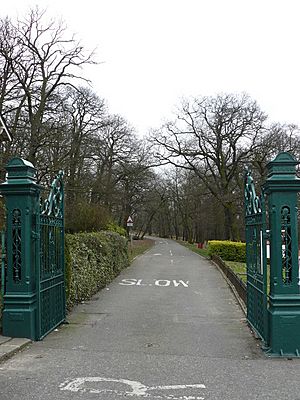Grangewood Park facts for kids
Grangewood Park is a large woodland area found in South Norwood, London. The London Borough of Croydon looks after it. The park is surrounded by Grange Road, Wharncliffe Road, and Ross Road. It covers about 27.75 acres (11.23 hectares). You can find it on the main A212 road (Grange Road) between Thornton Heath and Upper Norwood/Crystal Palace. The closest train stations are Thornton Heath, Selhurst, and Norwood Junction.
Contents
What Can You Do at Grangewood Park?
Grangewood Park has many fun things to do! You can enjoy:
- Woodland areas
- Beautiful ornamental gardens
- A special cultural garden
- A bowling green and a small building (pavilion)
- Tennis courts
- Multi-games courts (great for football)
- A children's playground
- Basketball hoops and kick-around areas
The History of Grangewood Park
Grangewood Park has a long and interesting past. It was once a much larger woodland area.
How Grangewood Park Got Its Name
Long ago, this area was part of a big estate called the Manor of Whitehorse. In 1787, a man named John Cator bought it. It was known as Whitehorse Wood back then. This wood was part of an even bigger forest called the Great North Wood (also known as Norwood).
Between 1299 and 1338, the Bishops of London owned this land. In 1368, the manor became known as White Horse. This was because Walter Whitehors, who worked for King Edward III, owned it. Before that, it was called Benchesham Manor.
Changes to the Land
When John Cator passed away in 1806, his nephew, also named John Cator, inherited the estate. He later sold it to a man named John Davidson Smith.
Around 1800, the wood was surrounded by open fields. The closest homes were small cottages near a farmhouse. By 1847, a path was built through the wood. This path connected Beulah Spa (which Davidson Smith had created) to a road junction at White Horse Farm. This path eventually became what we know today as Grange Road.
Davidson Smith decided to divide the large Whitehorse Estate into smaller pieces. He sold these pieces for people to build on. The eastern and western parts of Whitehorse Wood were cleared before 1850. The remaining 30 acres (12 hectares) to the east of Grange Road were then developed into a private estate.
The Mansion and Its Gardens
Old maps show how this private estate looked. A large mansion stood in the middle. Stables were located between the mansion and the main entrance. There was also a nursery and Ross Lodge to the east of the house. Another lodge, Wharncliffe Lodge, was at the main entrance. Heath Lodge, which is at the south end of the park today, was built later. It might have been added when a second entrance was made.
The mansion had beautiful gardens that stretched south from the house. Near Grange Road, there was a pond with a rustic bridge. The northern part of the estate remained woodland, with trees lining both sides of the garden.
Grangewood Park Becomes Public
In 1900, the Corporation of Croydon bought the park. They wanted to open it for everyone to enjoy. The Council then added a bowling green, tennis courts, and even a bandstand. Concerts were held there during the summer. However, these concerts became less popular, and the bandstand was later taken down.
The Mansion's Many Uses
The mansion itself was a two-storey Victorian building. It had bay windows, a veranda, and a glass conservatory on one corner. After the Corporation bought it, the mansion was used as a museum. It held collections of corals, shells, and old Roman items found nearby.
One room in the mansion was set aside as 'the Veterans' Club'. This was a place where local older people could meet and spend time together. Visitors could also buy refreshments from the tea-room inside the house.
The park's nursery was used by the Corporation to grow plants. In the autumn, the greenhouses were open for the public to visit. During the Second World War, the nursery was used to grow food. After the war, part of it was taken down to make space for tennis courts. In the mid-1960s, the nursery closed when a bigger central nursery for the Borough opened.
War and Damage
During the First World War, Canadian troops stayed in the mansion. In the Second World War, both the house and the park grounds were badly damaged.
The mansion had fallen into poor condition and was eventually taken down in 1960. Its foundations were then turned into a formal garden. The areas where the bay windows once were became flower beds.
Today, Grangewood Park is still a popular place. People love its oak woodland, gardens, sports facilities, and playground. In the spring, the steep bank next to Grange Road is covered with a beautiful display of daffodils.


